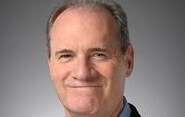I believe it is a good time to start thinking about life on the other side of the financial crisis. Today, the economy is still very weak, but there are some encouraging signs that support cautious optimism. I do not expect a strong recovery, but I do expect the economic contraction we are now experiencing to give way to slow and tentative growth.
Risks remain to this cautiously optimistic outlook. I am concerned about the commercial real estate sector and how its performance could affect the banking system. I am concerned that continuing job losses will reverse the slight indications of improving consumer confidence, and I continue to watch house prices with concern. House prices continue to fall, as indicated by the Case-Shiller index.
Along with these domestic risks, global risks are also considered in my outlook, given downward revisions in forecasts for gross domestic product growth in most major economies.
Nonetheless, I think this is an appropriate juncture to give more detailed and practical thought to the world we want to construct after this difficult period. In my remarks today, I plan to share my personal views (not necessarily those of my colleagues on the Federal Open Market Committee) on a basic question about the post-crisis environment: What regulatory environment will both align with the reality of financial markets and adequately address recent failings?
[b][i]About securitization[/b][/i]
There has been much discussion about restoring a commercial bank-dominant financial system, downsizing large systemically critical financial institutions to eliminate the too-big-to-fail problem and limiting the role of securitization. These are examples of opinions that range from predictions to prescriptions on what the financial system will look like.
The financial system has already undergone what some would call radical change. I'm referring to the reduction of the number of stand-alone investment banks, the conversion of some investment banks to bank holding companies and the forced consolidation of the commercial bank sector.
I'm cautious about predicting such substantial change going forward. I expect the financial system to continue to involve a mix of capital markets and institutions, but with a wider array of institutions falling under regulatory supervision.
Furthermore, I take it as given that there will continue to be large international institutions with operations in many countries – that is, regulatory jurisdictions around the globe.
Looking ahead, I see an ongoing role for securitization and the originate-to-distribute model. Securitization markets have shrunk dramatically over the last year and a half and, in some cases, have shut down altogether. I expect these markets to return, perhaps in simpler form, and with more accountability.
I expect securitization to continue, because this form of financial intermediation developed in response to needs and realities that have not disappeared. I was a commercial banker in the 1980s, and I remember well the onset of the practice of balance-sheet allocation according to return on assets and, ultimately, return on equity. Commercial banks were, and remain, caught in a dilemma of wanting to serve their clients by providing loans but not always being able to justify booking very competitively priced loans on their balance sheets.
This tension gave rise to various securitization, distribution and asset liquidity strategies, including off-balance-sheet vehicles, such as the now notorious structured investment vehicles. The excesses that arose need to be addressed, of course, but the underlying economics of 12:1 leverage banking continue to dictate that assets retained on balance sheets meet net interest margin and return requirements.
Banks must compete against all businesses for capital and seek competitive returns and earnings-per-share growth. In this respect, they do not compete only against other banks.
Securitization has brought benefits to consumers that cannot be easily matched by a bank that originates a loan to hold. In particular, mortgage securitization, which began in the 1980s, has led to lower mortgage rates, advancing the social goal of homeownership by improving affordability.
In more recent years, however, mortgage-backed securities have been engineered and resecuritized into increasingly complex structures known as collateralized debt obligations (CDOs) and even CDOs squared.
Investors in these securities relied on credit rating agencies to assess risk, and banks took advantage of regulatory arbitrage to conduct this business off balance sheet.
The resulting lack of transparency regarding the value of the securities and the financial condition of the banks holding them was a central factor in the financial turmoil of the last 18 months.
Going forward, markets and investors will show a new awareness of the potential for complexity, opacity and risk in securitized instruments.
This awareness, in and of itself, has and will continue to provide incentives for the creation of simpler and more transparent securitization structures. For these and other reasons, I expect our securitization system to be reformed, but not replaced.
[b][i]Oversight required[/i][/b]
The regulatory environment we construct in the coming months must be suited to a financial system that remains a mix of capital markets and institutions – formal and shadow banking – with an array of institutional operating models.
Against this reality, a system that responds to the perceived faults of the pre-crisis financial world by imposing a set of rules about what behaviors are prohibited is almost certain to amount to fighting the last war. I do not believe we can easily anticipate where the next source of stress in financial markets will arise.
In my view, the post-crisis environment will require agile oversight. This regulatory approach should stress actively managing risk as it evolves with the associated potential for an institution failing versus an approach that focuses on avoiding failure.
Following this logic, the regulatory environment we construct should be a well-balanced mix of rules and principles guiding flexible response and should also give a meaningful role to market discipline.
In an ideal world, effective market discipline necessarily allows for failure in a system in which no institution is too big (or interconnected, or complex, or operationally critical) to fail. It will take some time to achieve this ideal situation.
Several policy actions over the last year and a half have been about avoiding the failure of a large, systemically critical institution. It is important to emphasize that some of these actions took place in the absence of resolution authority – that is, the authority of a regulator to manage the failure of an insolvent institution in a purposeful and orderly manner.
In simple terms, resolution involves seizing control of the entity; finding an acquirer or acquirers; selling off assets; stabilizing funding arrangements, including insured depositors and counterparty exposures, working out unsold assets; allocating losses to shareholders, bondholders, wholesale depositors and other claimants; and managing final liquidation and shutdown, if required.
Though this list sounds relatively straightforward, aspects of it are extraordinarily complex. At the core of the systemic-risk issue is the fact that banks and other highly leveraged financial institutions are involved in a complex network of two-way, short-term funding arrangements.
The failure of a large, interconnected financial institution threatens the funding of its counterparties, which then threatens their counterparties, and so on.
The metaphor that seems apt is a chain of falling dominos. Any robust resolution process must come to grips with the potential for these sorts of network spillovers and include mechanisms for short-circuiting the potential cascade of counterparty failures when a lead domino falls.
[i]Dennis P. Lockhart is president and CEO of the Federal Reserve Bank of Atlanta. He can be reached at (650) 227-7300. This article is based on a speech delivered at the Levy Institute of Bard College in Annandale-on-Hudson, N.Y.[/i]











